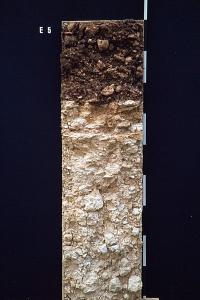Reference soil Spain 05: Calcisol
Calcisols occur in regions with distinct dry seasons, as well as in dry areas where carbonate-rich groundwater comes near the surface.
Characteristics
Soils having a (petro-)calcic horizon (horizon with accumulation of secondary calcium carbonates). In addition, they have no diagnostic horizons other than an ochric or cambic horizon, a calcareous argic horizon, or a gypsic horizon beneath a petrocalcic horizon.
Reference soil ES005: Calcisols
Short field description: A shallow well drained dark reddish-brown heavy texture, underlain by a white indurated very calcareous horizon; The cementation decreases with depth. The surface horizon contains many coarse fragments of calcareous material from below. The Ap1 horizon contains besides its massive structure pockets of very fine crumb and places of weak very fine subangular blocky structures. Soil erosion: The top part of the profile is probably washed away. * human activities for many centuries, resulting in truncation of the profile. References: On Petrocalcic horizons: Swineford & Byron Lemand & Frye, 1958, 'Petrology of the Pliocene pisolithic limestone in the Great Plains', In: 'State Geol. Survey of Kansas', Bull 130, II, University of Kansas, Lawrence, Kansas. Other: Nagtegaal, 1969, 'Microtextures in recent and ferric Caliche', In: 'Leidse Geol. Med.', deel 42, pp 131-143. Thompson, 1955, 'The thermodynamic basis for the mineral concept', pp 65-103. XXX The depth of the samples is not precizely known. According to no. 482 there must be a differentiation of horizons at 22-23 cm; According to no. 481 this is not correct.
